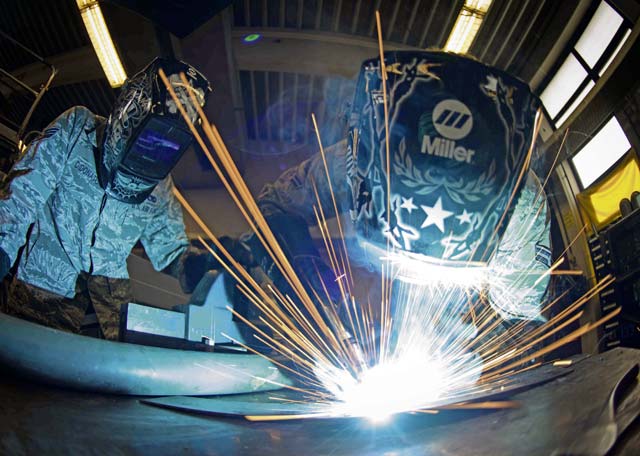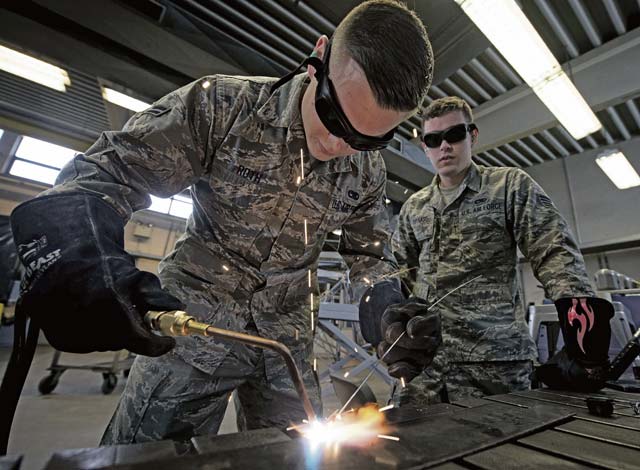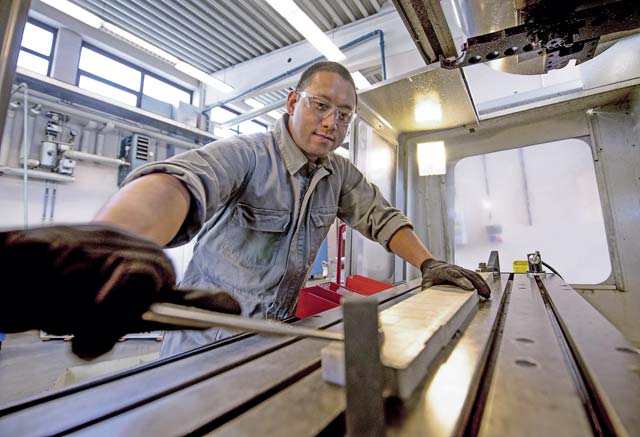
Though lives often depend on the missions flying out of Ramstein, all it takes is one broken part to keep a plane from flying. That’s why the 86th Maintenance Squadron Aircraft Metals Technology shop makes sure that if any aircraft on the Ramstein flight line needs parts, they get parts any time, any day.
The Aircraft Metals Technology shop employs a skilled group of Airmen, who turn hunks of steel and aluminum into any part or tool the flight line asks for. Their shop is supplied with large, heavy machines and torches designed to mill and weld metal into sturdy, functional aircraft parts and tools.
Master Sgt. Joseph Slaughter, 86 MXS Fabrication Flight assistant flight chief, said many times the flight line is not able to simply order products ready-made.
“As these airframes age, the availability of spare parts becomes more and more scarce,” Slaughter said. “For example, the B-1B Lancer has no parts manufactured for it anymore. If anything breaks on it, aircraft metals technology is solely responsible for replacing that. We manufacture it from scrap, from a block of metal.”
Even if the part is available, Slaughter explained, a product may have to travel half way across the world to get to Ramstein. When lives are on the line, there is no time to wait.
“One time there was a C-17 Globemaster III on a medical evacuation mission, ready to go pick up people from the field,” Slaughter said. “We had to manufacture a tool for the pressure check system so that the aircraft could be repaired and complete its mission.”
For reasons like this, aircraft metals technology Airmen are prepared to respond 24 hours a day, seven days a week.

According to Slaughter, an Airman may jump out of bed to put on protective glasses and turn a rod of steel into a bolt. He may program the computer numerical control milling machine to form a bar of aluminum into a deck panel door support. He may pull on heavy gloves and a full-face mask, fire up a torch and shower the shop with sparks on the metal insert gas welder.
“If these guys weren’t giving me their all, we’d be backlogged,” Slaughter said.
One of Slaughter’s skilled Airmen is Staff Sgt. Brandon Didonato, 86 MXS aircraft metals technology technician.
“We do a lot,” Didonato said. “We don’t usually say no to a request, so we work pretty hard. When the calls come in, they can pile up. Then you’re working late.”
The job requires attention to detail and minute accuracy. Didonato explained that when it comes to machining, a mistake means throwing away the product and starting over. That can mean hours of work are scrapped.
“Everything on an aircraft has to be precise to about two- or three-thousandths of an inch,” Didonato said. “If one side of a part is 50-thousandths of an inch too big, it won’t fit. It’s like a jigsaw puzzle.”
The Air Force counts on aircraft metals technology to make every part the right length and width. Every angle has to have a precise measurement, or the plane won’t fly. With all that responsibility riding on their shoulders, the shop has to pull together and work hard.
Slaughter said being prepared to come in early and stay late is an important part of what keeps airlift running at Ramstein and when it comes to his shop’s performance, he is impressed all the time. He said it is not just the dedication his Airmen have for the job, it’s the dedication they have for each other.
“We have one person who covers standby after hours for a week at a time,” Slaughter said. “It’s easy to go home and let that person stay behind, but that’s not the case with this shop. We’ll stay behind collectively so that person isn’t left behind. He has friends there with him. Sometimes this job can be really stressful. It can be infuriating and frustrating, but to know that your friends and coworkers are there to help you out makes it more bearable.”

Slaughter helps bring perspective to the stress that comes with the job by helping his Airmen realize the impact of their dedication.
“A commander that I had a few years ago said it best,” Slaughter said. “‘Every moment that an airplane is not in the air doing its mission, people have the potential to die or get injured. That’s a family member who won’t go home and see their son or daughter or wife again.’ I try to instill that in these guys. It might seem like it’s just another sortie, but you don’t know what that aircraft is going to be supporting. So give it your all. Someday it’s going to be saving someone’s life.”


